Category: Interaction Design
Advanced Project Course in Interaction Design at KTH
Loved being a part of the Advanced Project Course in Interaction Design with Jarmo, a colleague at KTH! In this new course that took place this past fall (2017), students carried out a small research project in close collaboration with KTH researchers. In addition to assisting with course admin and examination, I also supervised a group of three students working on a pee-ometer – a device that predicts when someone has to pee – for my research on implicit interactions and machine learning as a design material. Looking forward to running the course again this coming fall!
AAAI 2018 – Presentation & Slides
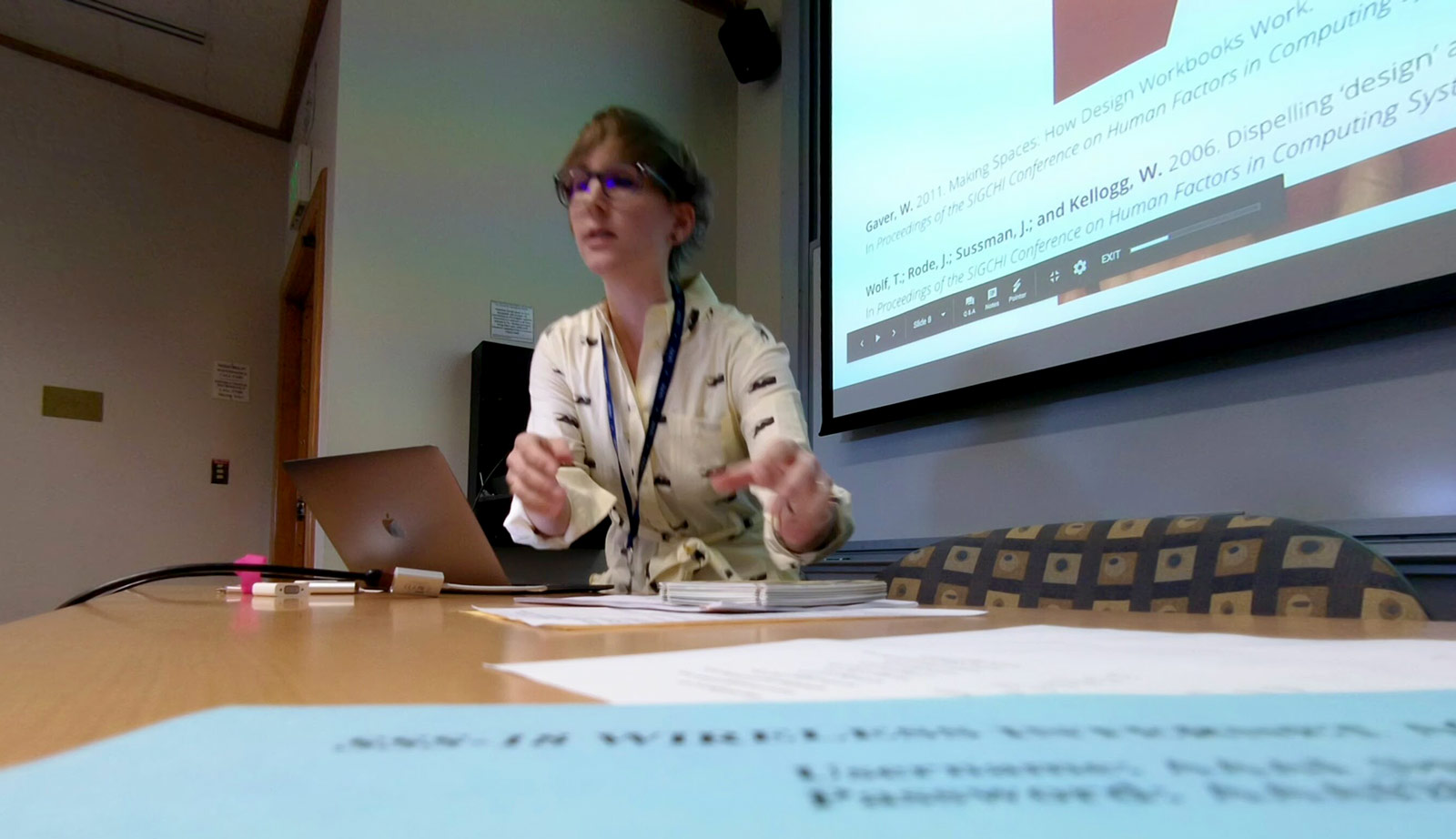
Last week I presented my paper Design Methods to Investigate User Experiences of Artificial Intelligence at the 2018 AAAI Spring Symposium on the User Experiences of Artificial Intelligence. The picture above was taken by a Google Clips camera, which was also one of the presented papers. Below are my slides, which contain supplementary images to my paper on the three design methods I have engaged with relative to the UX of AI. Another blog post will soon follow with reflections on other papers presented.
CHI 2018 – Attending Workshop on HCI Outdoors
This year I’ll be going to CHI 2018 as a student volunteer and to attend the workshop HCI Outdoors: Understanding Human-Computer Interaction in the Outdoors. Very much looking forward to connecting with the HCI outdoors community for a new research project!

A Walk in the Woods: Gear and Infrastructure in the Outdoors (position paper PDF)
In this position paper, we describe an initial research activity, a short walk in the woods, to position our interest in HCI and the outdoors. We present three preliminary reflections from our hike on relationships with gear and infrastructure that enable meaningful outdoor experiences. These include parallels between packing gear and preparing devices, contrasting notions within bodily comfort and brand allegiance, and safety bubbles enabled by actual or expected infrastructures.
AAAI 2018 – Accepted Spring Symposia Papers
Two papers were accepted to the AAAI 2018 Spring Symposia: Design Methods to Investigate User Experiences of Artificial Intelligence for The UX of AI symposium and The Smart Data Layer for Artificial Intelligence for the Internet of Everything symposium. I’ll be presenting the former at Stanford at the end of March, bellow is the abstract.

Design Methods to Investigate User Experiences of Artificial Intelligence
This paper engages with the challenges of designing ‘implicit interaction’, systems (or system features) in which actions are not actively guided or chosen by users but instead come from inference driven system activity. We discuss the difficulty of designing for such systems and outline three Research through Design approaches we have engaged with – first, creating a design workbook for implicit interaction, second, a workshop on designing with data that subverted the usual relationship with data, and lastly, an exploration of how a computer science notion, ‘leaky abstraction’, could be in turn misinterpreted to imagine new system uses and activities. Together these design activities outline some inventive new ways of designing User Experiences of Artificial Intelligence.
PhD’ing – Writers’ Retreat, Project Offsite, Outdoors Research, and Making Preciousness
Today I saw a meme on Instagram which said, “We are now entering the third month of January.” I couldn’t relate more! And looking back over the past few weeks, cannot believe all that has already happened in 2018.
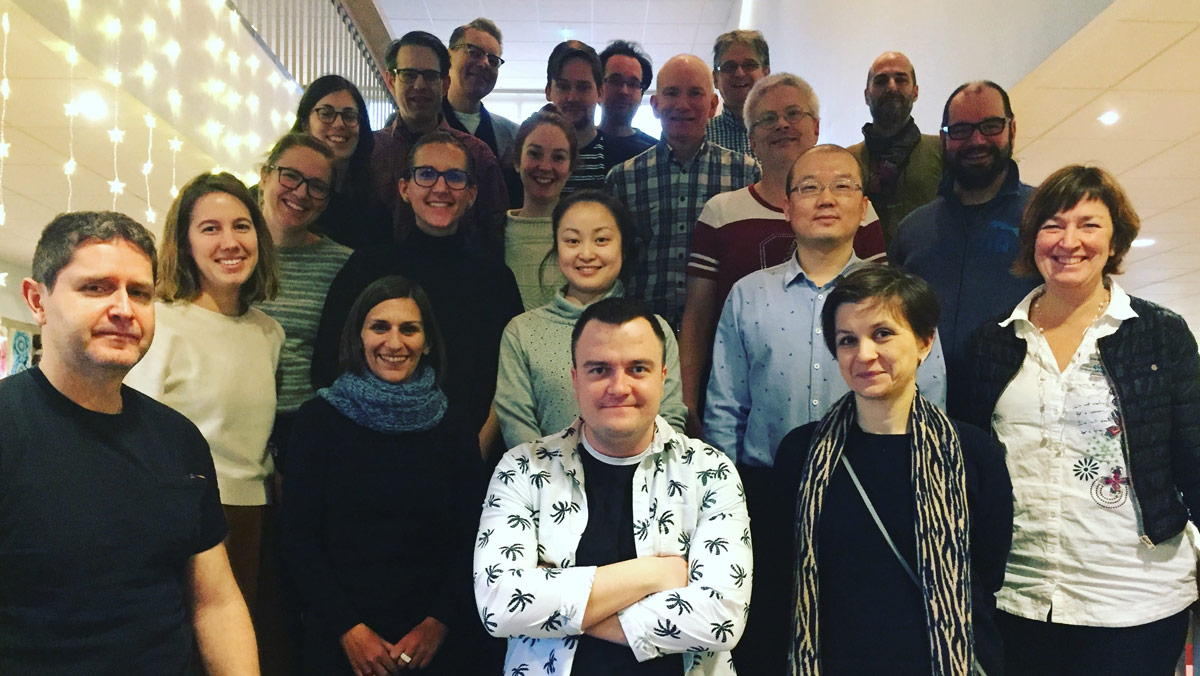
Writer’s Retreat
Following a paper deadline in early January, my department at KTH (Media Technology and Interaction Design) kicked off 2018 with a writers’ retreat. What happens at a writers’ retreat? We book a venue in the Stockholm archipelago for three days and two nights, and write. And sauna and winter swim, but mainly write. The primary purpose of the retreat is to provide time and space away from everyday academic duties, from teaching to admin responsibilities, in order to focus on increasing the quality and quantity of our writing output. During the three days, we follow an agile framework in which junior/senior pairs write in ~45 minute sprints and then provide ~15 minutes of feedback. In addition to intense writing blocks, lunches, dinners, and evening activities provide ample opportunities to better know our colleagues professionally and personally. Though equally as exhausting as the writing, this social time I find incredibly valuable in creating a continued collaborative culture at work.
During this year’s writing camp I started a paper on a Pee-ometer, a recent project by Master’s students that I proposed and supervised in which they prototyped a wearable device that predicts when a user has to pee to investigate Machine Learning as a design material.
Project Offsite
In mid January, the Smart Implicit Interaction project had a two day project offsite. As the project is composed of differing philosophical and methodological backgrounds – i.e. Artificial Intelligence, Social Sciences, and Interaction Design – the first day consisted of a beginners overview into reinforcement and representational learning in neural networks to introduce technical terminology and objectives. During the second day, all of the sub-projects presented their current status and goals for the year. I specifically presented two ongoing design projects, data-driven design methods and the Pee-ometer. In the former, I discussed early design activities and resulting concepts from investigating the implications of screenshots as a data source. In the latter, I discussed three high-level interests guiding future project directions, including Machine Learning as a design material, interactional loops, and critique and ethics. Overall, it was inspiring to share and strategize better collaborations while revisiting overarching project objectives.
Project Offsite
Last week continued January’s streak of out-of-office research activities and into the forest. To kick off an new outdoors project, myself and three senior researchers went on a mid-week day hike 30 minutes outside of Stockholm. Not only was I surprised at a Professor’s ability to make a fire in the snow, but the excursion was both refreshing and constructive. More in the coming months!
Making Preciousness
And last but definitely not least, friend and fellow PhD student Vasiliki successfully defended her thesis Making Preciousness: Interaction Design Through Studio Crafts. Her opponent Ron Wakkary gave a much deserved brilliant presentation of her work before lengthy discussions with him and the committee. Admittedly, it is selfishly bittersweet to see her finishing as she has been a tremendous support and inspiration during the first year of my own PhD.
TEI 2018 – Studio Call for Participation
Sociomateriality: Infrastructuring and Appropriation of Artifacts
Novel materials and innovative applications can sometimes outweigh a reflective perspective on the roles that objects and materials can play in social life. In this Studio, we want to bring together researchers and practitioners who are interested in exploring design outcomes from a sociomaterial perspective. By having prototypes at the center of the Studio activities, we intend to create prompted speculative fictions that link the material outcomes of design practice to social agency and cultural effects.
This studio will offer an opportunity to examine how objects might participate in social spheres as well as act as material bridges to their design process. We will do this through both hands-on examination of design objects, and inquiry into the infrastructuring and appropriation of these artifacts. The themes that will be examined are agency, material participation, and cultural performance of things. We encourage participants to bring their own prototypes.
We invite scholars and design practitioners from a variety of fields to register on the TEI 2018 website. For any questions, email the workshop organizers at mailto:hello@sociomaterial-things.com.
For any questions, email the workshop organizers at:
mailto:hello@sociomaterial-things.com.
More information you can find at the Studio webpage:
http://sociomaterial-things.com
Organizers
Tom Jenkins – Georgia Institute of Technology
Vasiliki Tsaknaki – KTH Royal Institute of Technology
Karey Helms – KTH Royal Institute of Technology
Ludvig Elblaus – KTH Royal Institute of Technology
Nicolai Brodersen Hansen – TU Eindhoven
PhD’ing – Taboo, Tinkle, Algorithms, and Home
For an autobiographical project building off Leaky Objects, in which I’m allowing myself to undertake a significantly slow design process, this week I read Geography of Home: Writings on Where We Live by Akiko Busch. The book is a collection of beautiful musings organized by room and touches upon notions of comfort, dichotomies between possessions and spaces, clutter, deeply personal rituals, thresholds, processions, and changing functionalities. So much I love in this book while mapping the geography of our tiny home which defies all traditional expectations and conditions. Last year before moving from London to Stockholm, we read The Life-Changing Magic of Tidying Up, an amusing read that we nevertheless abided by and asked everything we own, “Do you bring me joy?” Not only did we end up giving away bags of stuff, but it also prompted many meaningful discussions regarding and aligning views on possessions and a home, in addition to musings around if someday everything will be connected, will all our possessions? And why do we keep them, and do we deserve them if possession implies care, custody, and guardianship? More and more through many of my ongoing projects and initial concepts, I realize I’m interested in overlaps between privacy and care, and perhaps comfort too.
A project I recently started with MSc students is investigating predicting pee habits, which to many is a taboo topic due to the invasive nature of the proposed interaction and an aversion to recognizing private bodily functions. A subsequent discussion with my supervisor on researching taboo topics led to the reading of the paper Accountabilities of Presence: Reframing Location-Based Systems and the website Between the Bars: Human Stories from Prison. In the paper, the authors research paroled sex offenders who are tracked via GPS to explore the intersection between mobility, presence, and privacy; while the website offers a digital platform to share handwritten content from people in prison who do not have access to internet. In both cases, what could be considered extreme or fringe users are researched or designed for, and equally interesting for different reasons, they also serve as interesting case studies that either directly learn from or address the messy realities of society. One of my biggest peeves – designers don’t address the messiness of life nearly enough. So while pee might not be prison, it is definitely an everyday and occasionally very messy, mundane, and universal reality that should not be ignored as I believe there is much to be gained from deviating from designing only delightful experiences.
On a fun, related note, I recently found out that Engelbart conceived what he called the “tinkle toy”, a small waterwheel in a toilet bowl that would spin when pee was run over it, serving as a potty-training aid for boys as the interaction was designed to be an incentive to pee in the toilet. From Markoff’s What the Dormouse Said: How the Sixties Counterculture Shaped the Personal Computer Industry.
A week or two ago, it was difficult to miss Algorithms as culture: Some tactics for the ethnography of algorithmic systems on Twitter. Found it incredibly informative and a nice compliment to Dourish’s The Stuff of Bits: An Essay on the Materialities of Information, which I started last week for implicit interaction book club. The paper also led me to these slides The algorithm multiple, the algorithm material: Reconstructing Creative Practice – in which I was thrilled to see my former UVa architecture professor and brief employer Jason Johnson of Future Cities Lab mentioned.
Lastly, this morning I found this open source software by Rebecca Fiebrink for real-time, interactive Machine Learning that hopefully I can use with Arduino.
PhD’ing – Wonder, Autonomy, Frameworks, and Infrastructures
Trying something new with the aim of semi-regular updates regarding what I’m reading, working on, and thinking about.
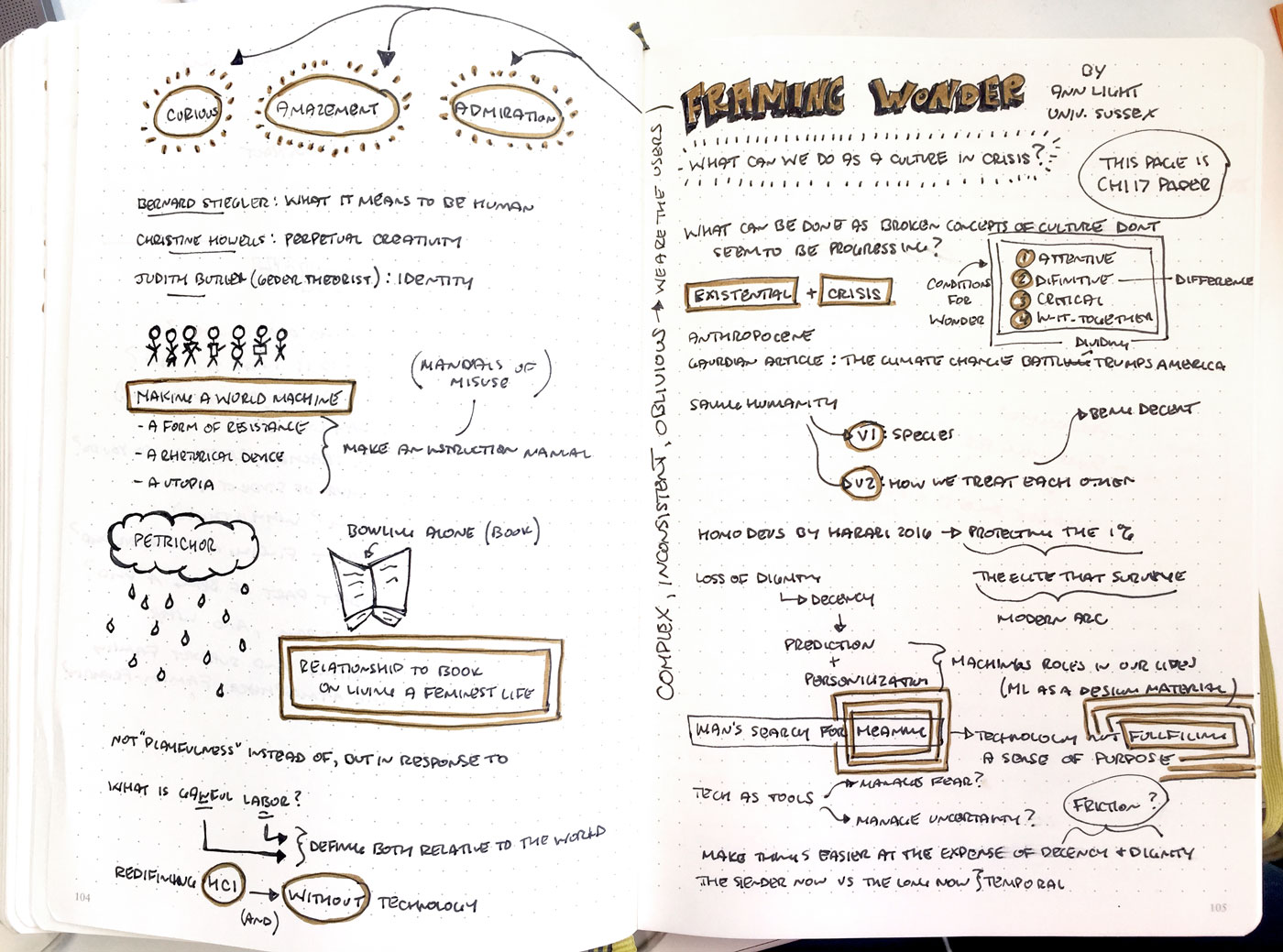
Last week had a short chat with Ann Light from the University of Sussex regarding my work and attended her guest lecture Framing Wonder: Beyond Design for Existential Crisis (sketch notes above). Dark yet very inspiring talk and highly recommend her related paper Design for Existential Crisis from CHI17. Both the talk and her paper inspired me to look into care ethics and feminist theory regarding my work.
For a recent paper and my ongoing multi-disciplinary project work, have been thinking a lot about Terry Winograd’s Shifting viewpoints: Artificial intelligence and human–computer interaction, in particular how to work across philosophical and methodological differences.
Based on a colleague recommendation, recently listened to Our Robots, Ourselves: Robotics and the Myths of Autonomy by David Mindell, a very accessible contribution to discourse on the meaning of autonomy. Throughout the book, within each of many case studies, he repeatedly challenges listeners (readers) to ask, ‘Where are the people, which people are they, what are they doing, and when are they doing it?” as he proposes an emphasis on human-computer relationships rather than the idea or potential of replacement. My favorite of his examples regards remote control of Mars rovers from Earth bound operators and the coinciding debate if presence can be felt at such a distance and with significant time delays – is remote presence real presence?
Last week discussed Things That Keep Us Busy: The Elements of Interaction by Lars-Erik Janlert and Erik Stolterman in a research book club with a focus on Implicit Interaction. I found the book an easy read as it was very much like a collection of papers (which most of it draws from). While I appreciated the provision of definitions, frameworks and objective perspective – as in taking the object’s instead of the user’s perspective – overall there was much I disagreed with, in particular the notion that implicit interaction decreases interactivity, and found it difficult to maintain a narrow perspective that doesn’t regard the social or systemic implications. Perhaps also, it seemed to contrast philosophically with Dewey’s Art of Experience which I am reading for a PhD course on the theoretical foundations of UX, and as a design researcher situated in a technical university am over-resisting the application of frameworks upon a field dependent on embracing the subject, chaotic, and messy nature of the world.
Attended a great talk by my friend Lorenzo at IxDA Stockholm’s event Questions and answers in the design process with Nordic Morning. Great nuggets regarding the materialization of cultures to engage people in discourse and materialization of infrastructures to enable designers to transform them. Definitely calls for a revisit of his paper Materializing infrastructures for participatory hacking.
Lastly, in addition to a bunch of course grading, this week I’ll be continuing concepts derived from a recent project workshop on designing with data and starting a new project with three KTH master’s student on prototypes to probe the notion of training when approaching Machine Learning as a design material. A related paper includes UX Design Innovation: Challenges for Working with Machine Learning as a Design Material.
EuroIA 2017 – Smart Implicit Interactions
Two weeks ago I had a lovely time speaking about my current research interests and questions surrounding Smart Implicit Interactions with industry practitioners at EuroIA 2017 in Stockholm!
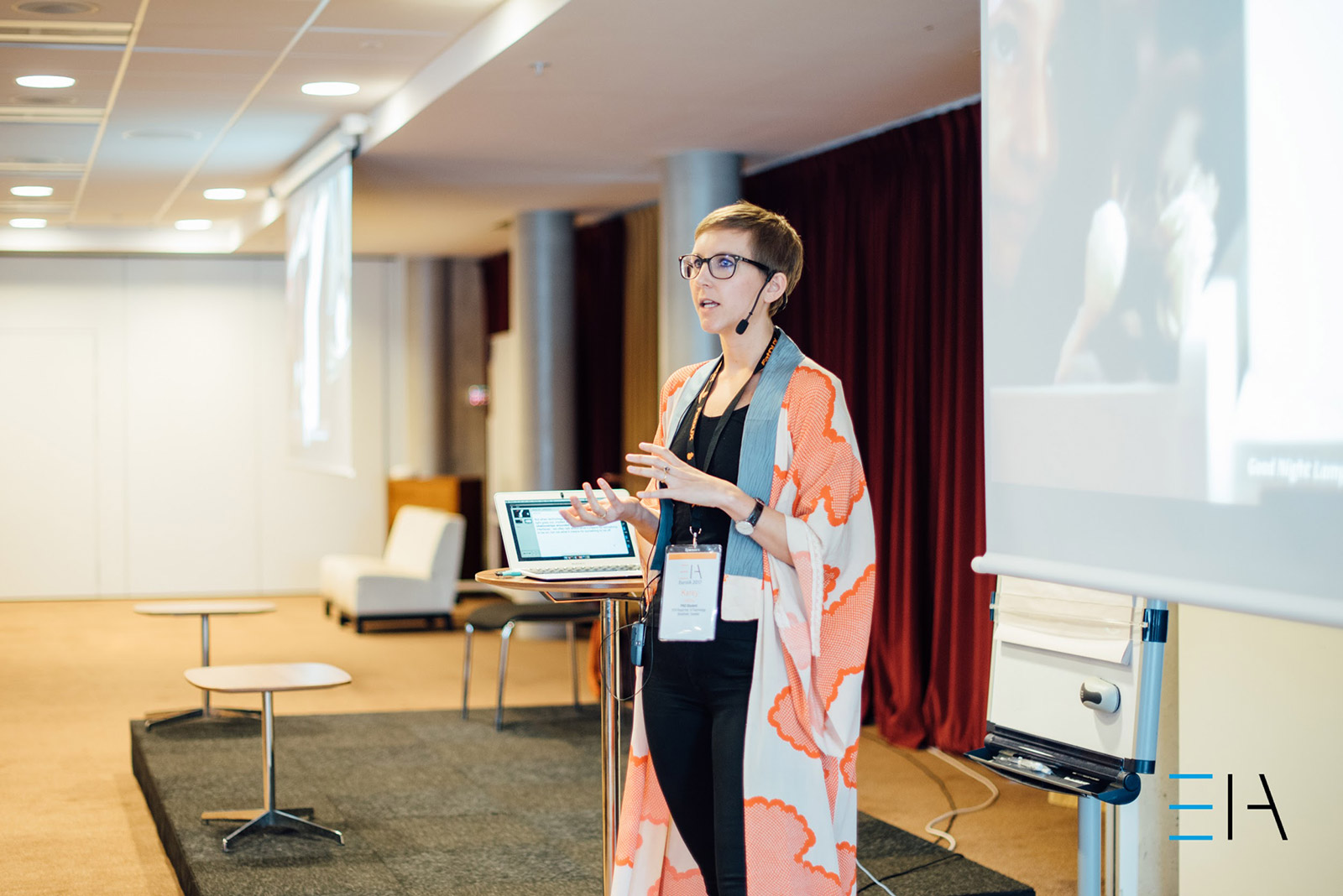
Thanks EuroIA for the INTENSE photo above and Inge Nahuis for the sketchnotes below!
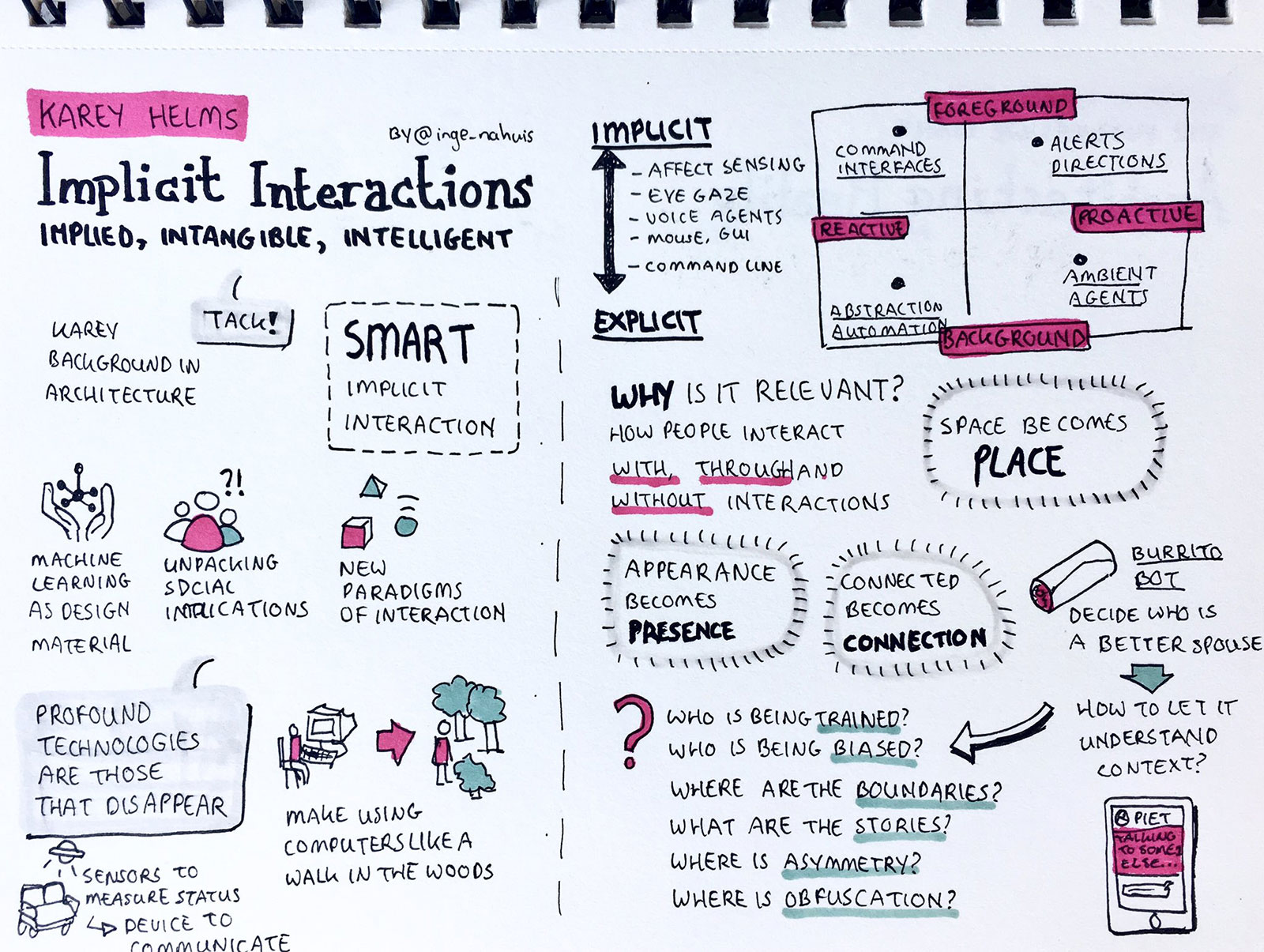
DIS 2017 – Workshop Reflections and Design Fiction
As previously mentioned, I attended, and thoroughly enjoyed, the workshop at DIS17 on People, Personal Data and the Built Environment. Not only was the topic relevant to my project, interests, and background, but I also found the strict structure (and quick introductions) very effective and thus resulting in meaningful discussions at the end of the day.
The below image is a fraction of a future IoT system followed by a corresponding fictional narrative created with Albrecht Kurze.

Unfinished Business
2022 – five years after 2017 – a public space odyssey
It is the year 2022, five years after the government started to implement the dynamic waiting management system in public buildings. To simultaneously reduce waiting times while keeping visitors preoccupied, the system routes visitors on an adaptive, and often the least efficient, way through the building. As this has unsurprisingly resulted in many lost visitors, a place-based location-aware voice-controlled guiding and help-and-get-helped system was introduced, in which visitors can leave voice messages to aid other lost visitors.
Dave was born in 1950 and retired in 2017, the same year his wife died. Every time he enters public buildings, he is asked to confirm the usage and data processing terms of the building, as smart building are being classified as interactive data processing units by the 2019 extended GDPR. These temporary consents are based on minimum viable data and are thus only valid for a single visit as all data collected is automatically deleted or anonymized upon leaving.
Dave pretends to apply for a hunting license but actually just wants to hear his wife’s voice in a message she left in the help-and-get-helped system after the system’s implementation. As the system is gender intelligent, he needs a female to find his wife’s message. Furthermore, the message is not locationally linked nor directly addressable because of dynamic shuffling and the anonymization policy.
Claire was born in 2001 and has been applying for a family planning permit for the past five days. As the system is implicitly regulating family planning, prioritizing lonely widows and widowers for which Claire is not, it sends her on an impossible route. As she is not successful in her quest for a permit by the end of each day, the temporary data consent causes her to restart the whole process the following day, resulting in a never ending journey.
But this one special day Dave and Claire met, two lost visitors, trapped some way in and by the system. They decided to help each other and resolve their unfinished business.
DIS 2017 – Poster Presentation of Leaky Objects
Last week at DIS 2017 in Edinburgh I presented a poster (pdf) for my work-in-progress Leaky Objects: Implicit Information, Unintentional Communication. Very thankful for the discussions and feedback!
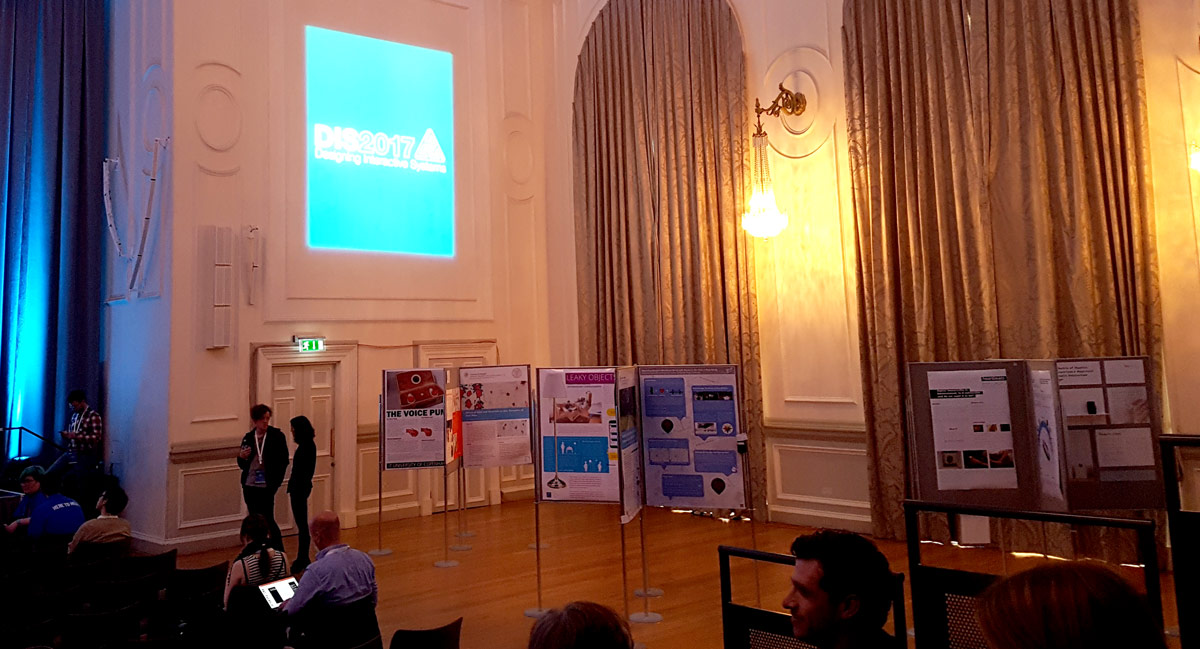
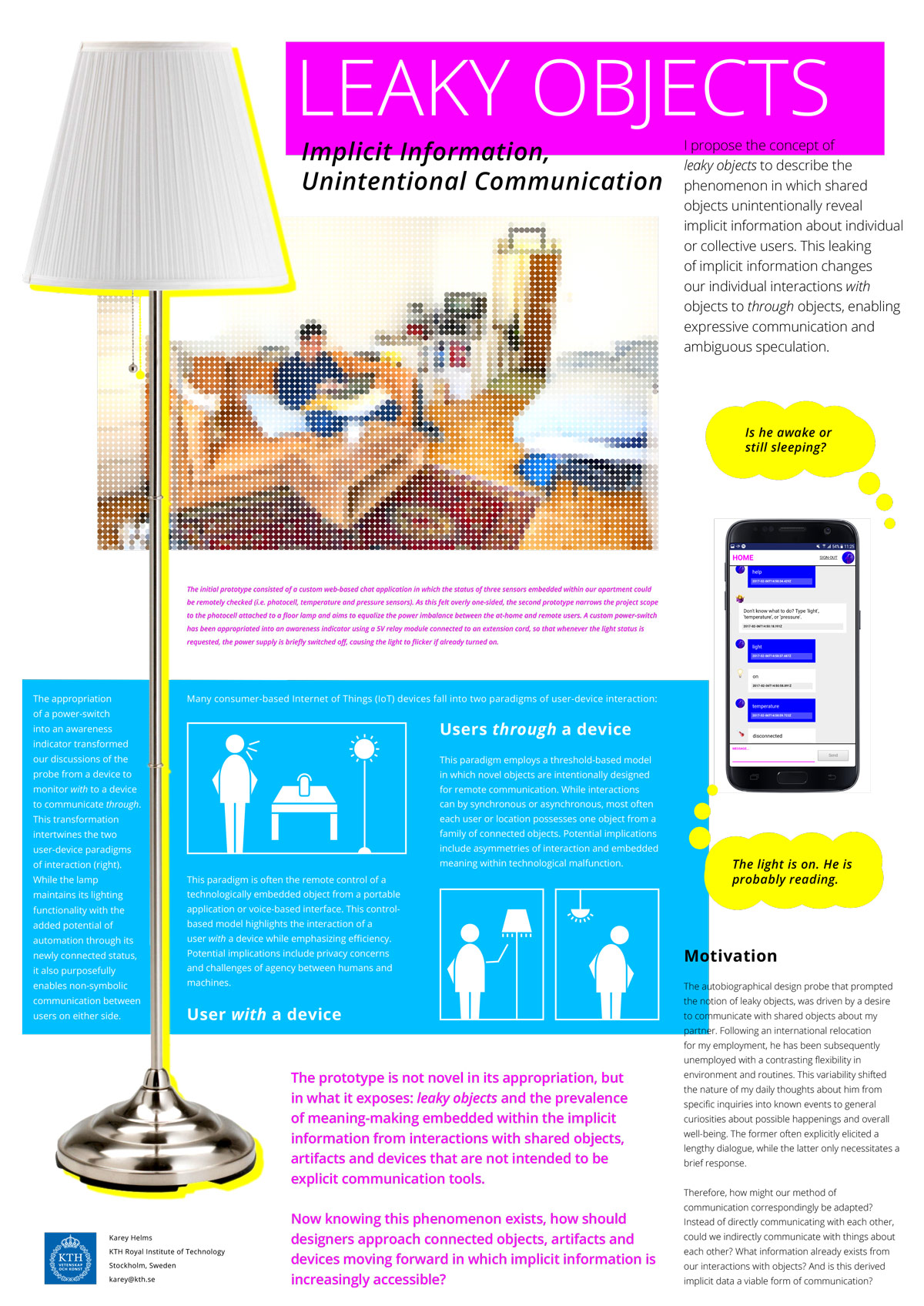
DIS 2017 – Workshop on People, Personal Data and the Built Environment
Yesterday I attended the workshop Workshop on People, Personal Data and the Built Environment at DIS 2017. Was incredibly inspiring and perhaps the best workshop format I’ve experienced as of yet! Below is my position paper.
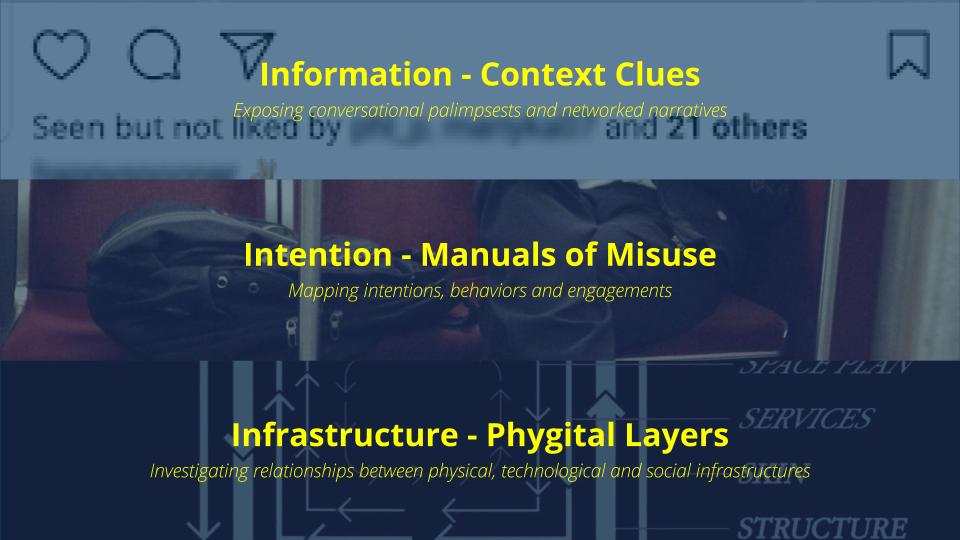
Implicit Interaction: Information, Intention and Infrastructure (position paper PDF)
In this position paper I present three in-progress design projects that are initial explorations into Smart Implicit Interaction, which is investigating data as a design material and a new paradigm of interaction for the Internet of Things. The first project, Context Clues, critically examines our existing interactions and exchange of implicit information across digital mediums. The second project, Manuals of Misuse, is an Internet of Things design brief in which students are exploring the peripheral intentions embedded within everyday objects to design novel connections while exposing hidden patterns of behavior and engagement. The third project, Phygital Layers, is an architectural study seeking to understand the implicit relationships between physical, technological and social infrastructures within domestic environments. While all three projects differ across scale and medium, they offer potential avenues of investigation into designing for people, data and the built environment.
EuroIA 2017 – Upcoming talk on Implicit Interactions
Very excited to be giving a 20 minute talk on September 30th at EuroIA in Stockholm on Implicit Interactions: Implied, Intangible and Intelligent! Below is my talk abstract.
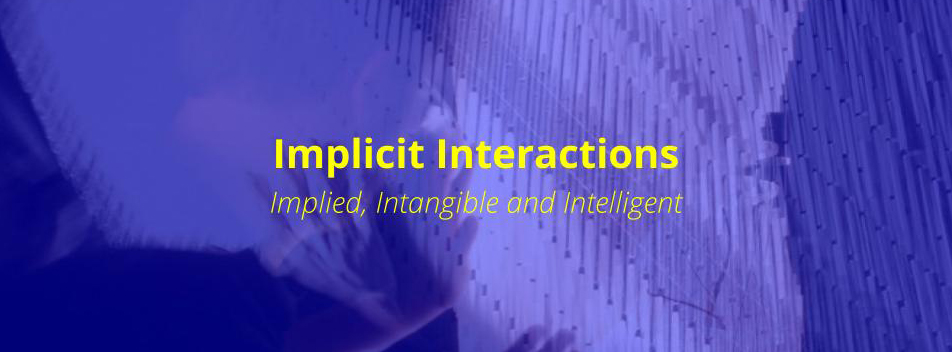
As our physical and digital environments are ubiquitously embedded with intelligence, our interactions with technology are becoming increasingly dynamic, contextual and intangible. This transformation more importantly signifies a shift from explicit to implicit interactions. Explicit interactions contain information that demands our attention for direct engagement or manipulation. For example, a physical door with a ‘push’ sign clearly describes the required action for a person to enter a space. In contrast, implicit interactions rely on peripheral information to seamlessly behave in the background. For example, a physical door with motion sensors that automatically opens as a person approaches, predicting intent and appropriately responding without explicit contact or communication.
As ambient agents, intelligent assistants and proactive bots drive this shift from explicit to implicit interactions in our information spaces, what are the implications for everyday user experiences? And how do we architect dynamic, personal information in shared, phygital environments?
This talk aims to answer the above questions by first introducing an overview of explicit and implicit interactions in our mundane physical and digital environments. Then we will examine case studies in which unintended and unwanted consequences occur, revealing complex design challenges. Finally, we will conclude with example projects that explore a choreography between explicit and implicit interactions, and the resulting insights into architecting implied, intangible and intelligent information.
DIS 2017 – Accepted Works-in-Progress (PWiP)
Both very unexpected and exciting to have a work-in-progress accepted to DIS 2017 in Edinburgh. I wrote about an ongoing autobiographical design project that was started this spring along side a few other explorations to kick-start my PhD at KTH this year. Very thankful to Kia Höök who talked me through my insight at a KTH Interaction Design writer’s camp in March and the reviewers who gave great feedback on how to continue developing it into a full paper.
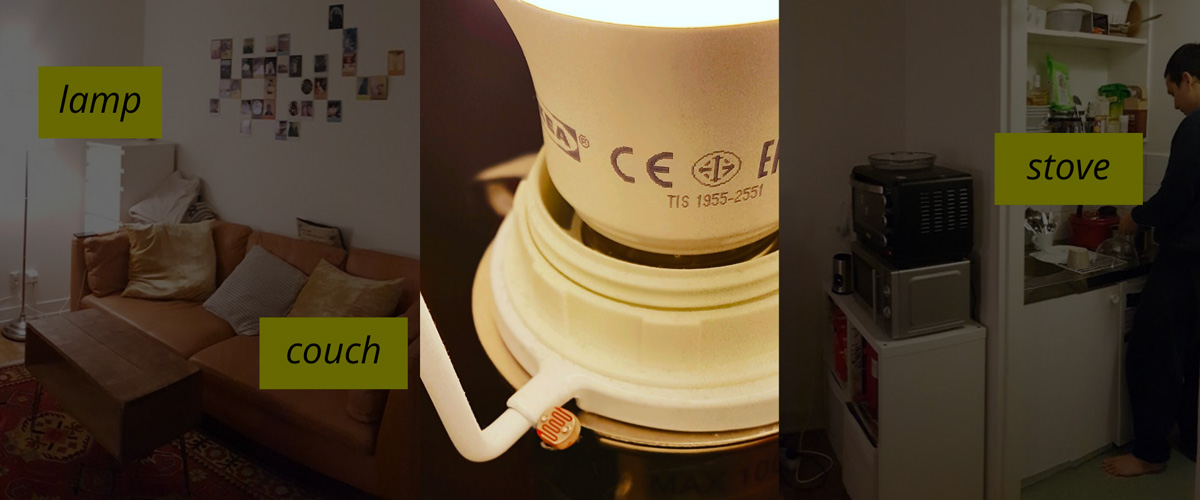
Leaky Objects: Implicit Information, Unintentional Communication (PDF)
This paper introduces the concept of leaky objects to describe this phenomenon in which shared objects unintentionally reveal implicit information about individual or collective users. This leaking of implicit information changes our individual interactions with objects to through objects, enabling expressive communication and ambiguous speculation. The aim of this paper is raise awareness of this phenomenon through an ongoing autobiographical design probe in which remote interpersonal communication through a connected object is being explored, and raise questions regarding the potential implications for designers.
Workshop – The Cultures of Machine Participation
Earlier this week I attended a workshop held by the research group for the design of information systems (DESIGN) at the University of Oslo (UiO) on The Cultures of Machine Participation.
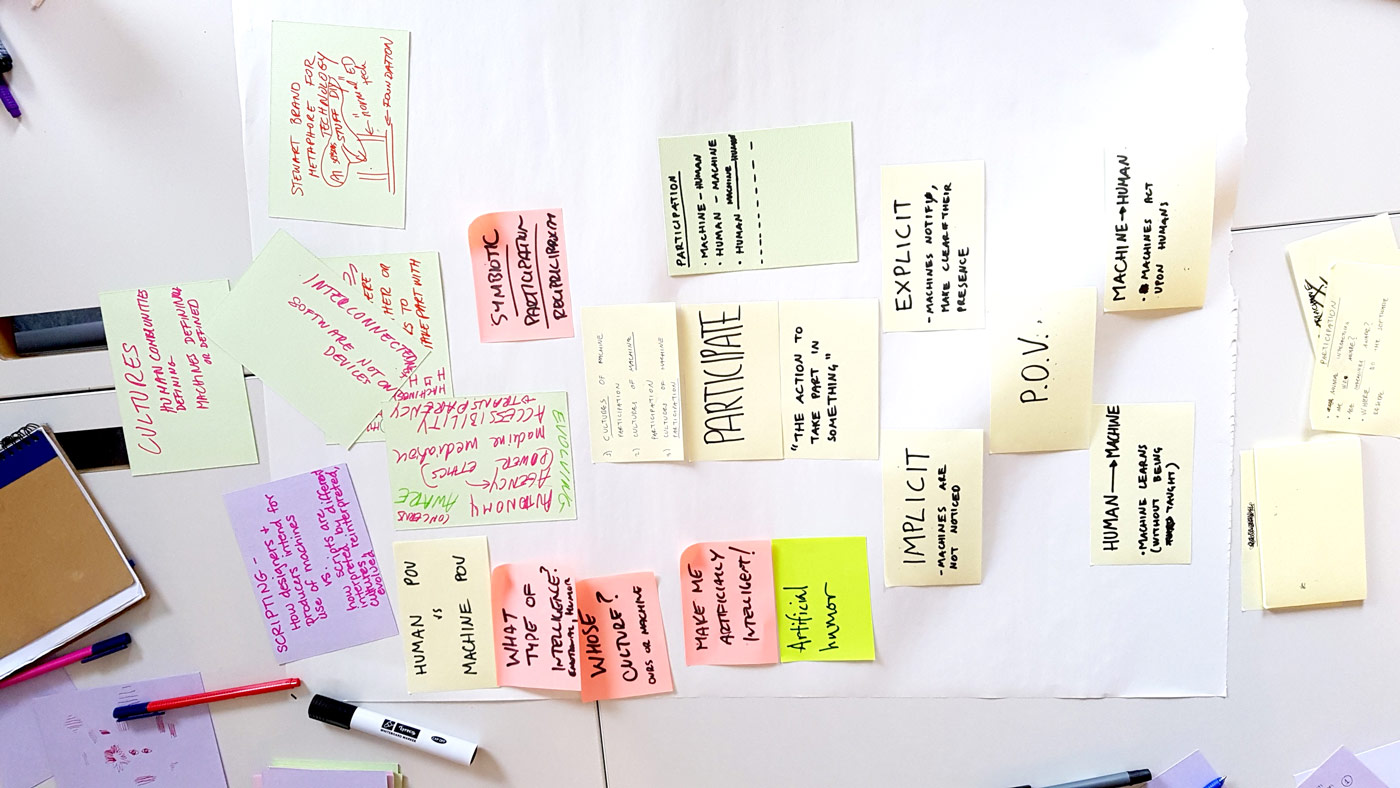
Design Brief – Manuals of Misuse
Below is the design brief that I wrote for the master’s level course in which I am a Teaching Assistant. The course is Interaction Design as a Reflective Practice.
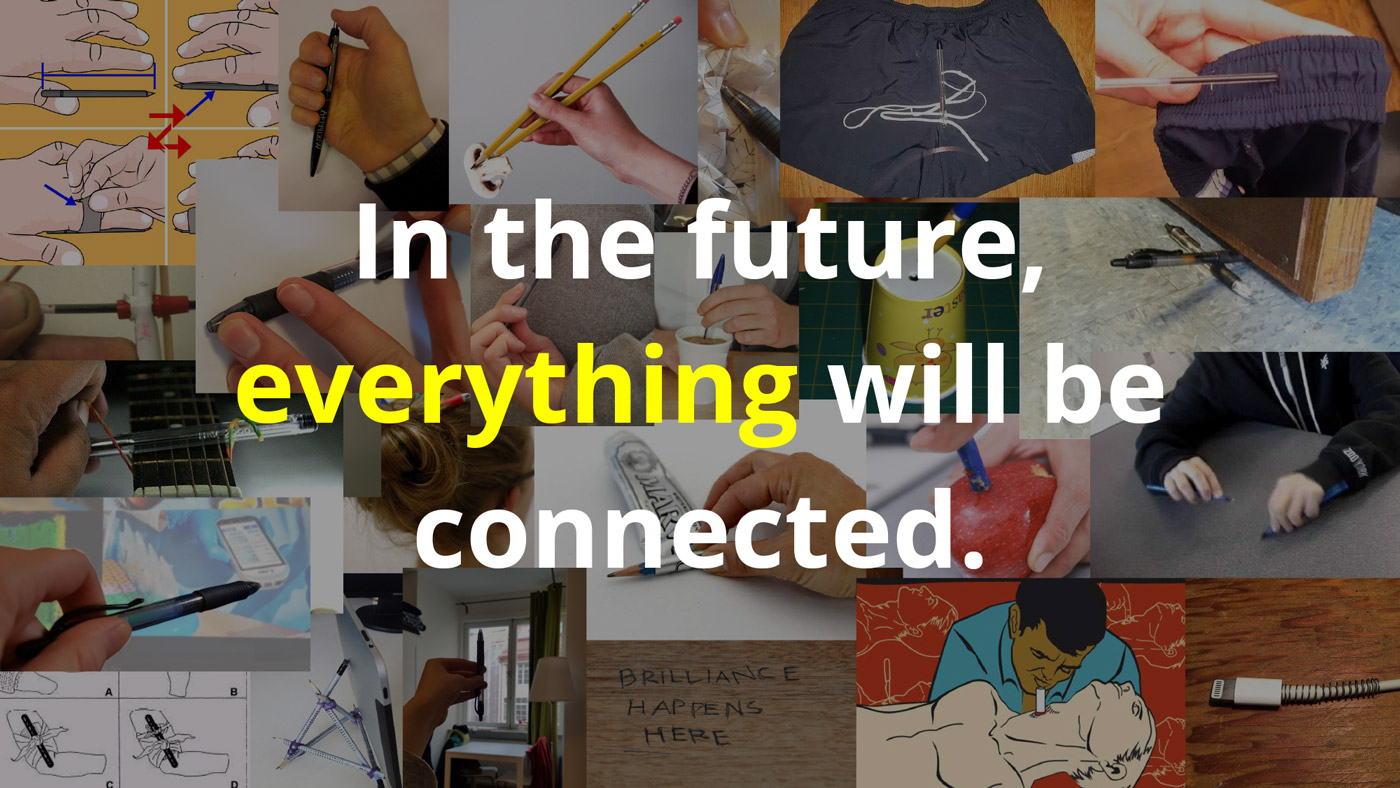
Design Brief
Technological forecasts often predict that someday in the future everything will be connected. What is everything? And why is connected so often synonymous with tangible interactions being transferred to mobile applications or voice-based assistants? Additionally, these solutions primarily focus on efficiency and automation, signaling a shift from engagement to a frictionless relationship with technology. Is this shift necessary, or do our physical things have overlooked abilities, hidden meanings or magical uses?
The project Manuals of Misuse investigates these questions by examining our everyday interactions with faceless objects and reimagining how they might be misused to playfully control or meaningfully communicate with other things, people or places.
You will do this by:
- Reflecting upon the intended interactions of an everyday object of your choice
What is the essential use of the object and the ideal scenarios of interactions? - Communicating how the object is meant to be used, interacted with and part of an ecosystem
What information is needed to communicate to a novice user, product partner, or manufacturer? - Investigating how the object is or could be misused – used for purposes not intended by the designer
What are the object’s properties and/or affordances that result in these misuses? - Generating novel design concepts of playful, meaningful or magical misuse
What modifications, interactions and technologies are required to make this possible? - Creating a stand-alone, multimedia experience that conveys your reimagined misuse
What is needed to communicate the essence of your concept and prompt further investigation?
Objectives
- Reflection: Upon our mundane, micro interactions with everyday objects. How to we use things and why do we use, or misuse, them? What can we learn from misuse and how does it inform how open or closed we design for appropriation?
- Communication: Of design intent, technical specifications and user experience to diverse audiences through various mediums.
- Playfulness: For engaged action and meaningful interaction.
- Documentation: For reflection and communication.
CHI 2017 – Attending Two Workshops
Very excited that I’ll be attending two workshops at CHI’17 in Denver! Below are links to the workshop descriptions and my position papers.
Workshop 1 – Making Home: Asserting Agency in the Age of IoT (description)
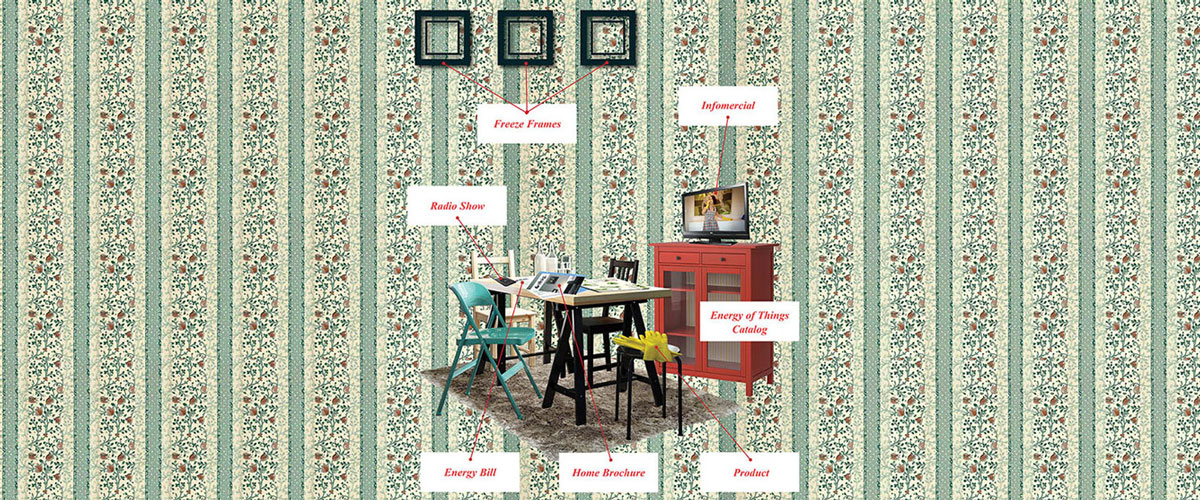
The Family Circuit: A New Narrative of American Domesticity (position paper PDF)
As the world endures and approaches a string of energy crises, The Family Circuit: A New Narrative of American Domesticity, aims to critique and challenge society’s relationship with energy by provoking individuals to examine their current habits of energy consumption, consider the future implications of these actions, and question their willingness to make sacrifices for a cleaner environment. This is accomplished through the development of a fictional near future society in which individuals are required to produce all the electrical energy that they need or desire to consume. Within the daily narrative of a fictional family of five, the events of their domestic lives have been extrapolated to create a liminal world where mundane, yet peculiar diegetic prototypes create tense situations, uncomfortable behaviors, and unforeseen consequences. The project raises questions regarding local to global contextual considerations, behavioral change within the home diegesis, and hyper-localized hacking.
Workshop 2 – Designing the Social Internet of Things (description)
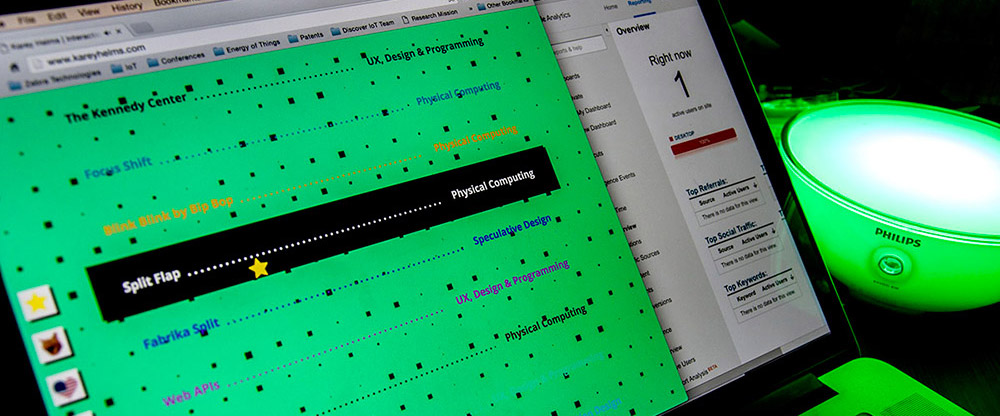
Phygital Party Mode: A Relationship with Relationships (position paper PDF)
In this position paper, I present an exploratory autobiographical design project, Phygital Party Mode, in which visitors’ interactions with my website remotely control an Internet of Things light within my apartment. I reflect upon my relationship with the project as a ‘thing’ and explore the themes of active versus reactive agency, conditional relationships and designing the behaviors of objects. Finally, I end with discussion questions that address a transfer of agency due the democratization of the Internet of Things, the transformation of relationships with and because of connected ‘things,’ and the empowerment of people over objects.
Industry to Academia, London to Stockholm
This week marks a big transition as I leave the complexities of enterprise UX at Zebra Technologies to pursue a PhD in Smart Implicit Interaction at KTH in Stockholm as part of a newly formed research group. My academic statement of intent below perhaps best expresses the culmination of my past experiences leading to my forthcoming journey. And the photo is of course just one of the many fond memories I will take with me.

Statement of Intent
“You think that because you understand ‘one’ that you must therefore understand ‘two’ because one and one make two. But you forget that you must also understand ‘and’.” ~ Sufi teaching story (Meadows, 2008)
Interests
On my first day of architecture school, we were asked to diagram where we come from and where we are now using a only a series of lines and dots on index cards. At the time, I was baffled by the task of reducing a complex, dynamic, and intimate answer into such simplistic, static, and impersonal elements. While this assignment ultimately ignited my interest in the pieces and processes of emergent systems and how the unique relationships between individual components inform and define the greater whole; more importantly, it cultivated analytical and divergent thinking. I learned how to isolate core components from a system, define explicit interactions in a space, situate functions within a context, and map parametric flows across time. Though eventually, my career pivoted from architecture to design as my intent transitioned from delight to meaning, and thus my thinking transformed from analytical to synthetic.
The primary differentiator between my experiences in architecture and design has been the latter’s focus on creative problem solving, or the convergence of disparate elements, activities, and intents to foster meaning. People have become the focus and embodied interaction the goal as I have strived to understand how space becomes place and appearance becomes presence. As an Interaction Designer, I design how people interact with, through, or without technology – an infinite and inclusive definition that ultimately focuses on people and prepositions, as it is the relationships that concern me. But as objects, environments, and worlds become ubiquitously intelligent, networked, and augmented, these relationships become increasingly dynamic, contextual, and intangible. I believe that negotiating these evolving relationships – to ultimately design meaningful new interaction modalities – is an exciting, challenging, and significant opportunity. Thus, I am interested in architecting the synthetic.
Pervasive and with unbounded potential, the “Internet of Things” is the key catalyst and instantiation of this paradigm shift towards implicit interactions. Moreover, as IoT infiltrates the mundane moments of our daily lives, it has the ability to transform our quality of life and achieve efficacious new futures from life-saving wearables to intelligent infrastructures. Though due to its systemic and embedded nature, both participative frameworks and contextual interventions are needed (as interaction is reciprocal), and thus both designs and the environments by which designers and users occupy, must be regarded. This duality necessitates divergent and convergent thinking, with a careful consideration of constraints, contexts, and intents. Therefore, through critical practice, ethnographic research, and situated prototypes, I aspire to explore what could be and what should be the intelligent dialogues of mediated, smart environments.
Capabilities
Over the past decade I have been afforded opportunities professionally, academically, and independently to cultivate the necessary skillset for the pursuit of a PhD in Interaction Design. Following the completion of my BS in Architecture, for over four years I was primarily self-employed as an Interaction Designer and Front-end Developer, working directly with clients from contract to concept to deployment. During this time, I was fortunate to work with a vast array of clients, expanding my formal digital design skills encompassing personas, user flows, information architecture, visual design, and UI development. Though more importantly, the empirical knowledge gained – pertaining to interpersonal and leadership skills, rigorous self-directed scheduling, and end-to-end digital product management and development – has been most invaluable.
My return to academia for my MFA in Interaction Design at Umeå University in 2012 was sparked by a desire to merge my physical and digital backgrounds within a formal user-centered education. My time in Umeå was marked by diverse and immersive collaborations with both peers and industry partners alike, who provided boundless intellectual stimulation while broadening my perspectives. I learned how to think critically and share imaginatively, perhaps best demonstrated in my speculative design thesis. Driven by a passion to critique and challenge society’s relationship with energy, I constructed a near future fictional society in which citizens are required to produce all the energy they desire to consume. Through liminal spaces and diegetic prototypes, I provoked polemical and productive dialogues, which were an engaging end to a wonderful graduate experience.
Following Umeå I moved to London and became a Senior Interaction Designer on the Innovation and Design Team at Zebra Technologies, an enterprise Internet of Things company. Within the constraints of business co-creation and the freedom of internal initiatives, my work investigates a product shift from isolated hardware and software to integrated systems and agents. In particular, I seek to design appropriate solutions at relevant fidelities that can enhance the cognitive and physical abilities of situationally disabled users in data-centric environments. For example, I am the Design Lead in a long-term co-creation project with a global transportation and logistics company seeking to improve organizational and workflow processes through custom 3D imaging technology and edge analytics. Besides traditional UX deliverables, my role includes ethnographic research, empathy mapping, stakeholder communication, service design, and a constant negotiation between implementable and transformational near future visions.
In addition to my role at Zebra, I actively engage in personal side projects which I playfully call “self-centered design.” Within these hypercritical explorations, I prototype manifestations of invisible interactions from the mundane moments of my daily life to gain insights into embodied interaction and socio-technical systems. Two ongoing projects are “Phygital Party Mode” and “Burrito.” The former is a phygital representation of online visitors’ interactions with my portfolio via Google Polymer, Firebase, Arduino, and Philips Hue technologies. Burrito is a manifestation of my marriage in the form of a bot that makes judgements on our relationship based on a mutually defined algorithm. Though perhaps a bit bonkers, both prototypes have resulted in instrumental insights that technically and creatively impact my professional development.
Motivation
My motivation to be a doctoral student is a combination of passion for the subject, drive to innovate in an immersive environment, desire to collaborate on a highly capable and motivated research team, and aspiration to contribute to academia via teaching. Throughout my educational background thus far, I have been fortunate to learn, collaborate, and contribute within competitive academic environments that seek and attain meaningful innovation. At both the University of Virginia and Umeå Institute of Design, I experienced firsthand the productive synthesis of cross-disciplinary participation and student-faculty engagement. These relationships were not only instrumental in my own development, but more importantly, contributed to the progress of meaningful experiences, emerging technology, and imaginative new futures. With diligent analysis and thoughtful synthesis, I would love to continue this trajectory at KTH with an inspiring team at a leading institution, and can guarantee that in addition to my credentials, I bring a healthy dose of gumption.
Meadows, Donella H. (2009). Thinking in Systems: a Primer. London, UK: Earthscan.
Interact 2016 – Insights in Self-centred Design
This week I spoke at Interact 2016 – slides and script below – a rather intimidating lineup alongside digital and physical architects whom all I greatly admire. I’m very grateful to Nomensa for the opportunity – not only is every talk an immense learning opportunity in public speaking, but I value even more the work prior – for the rigorous synthesis and curation of empirical insights is a process all designers should engage within as a practice of communication and reflection. Enjoy!
IxDA London – Implicit Interactions
Last night I guest hosted and organized an IxDA London event on Implicit Interactions at IDEO. Below is the event description.
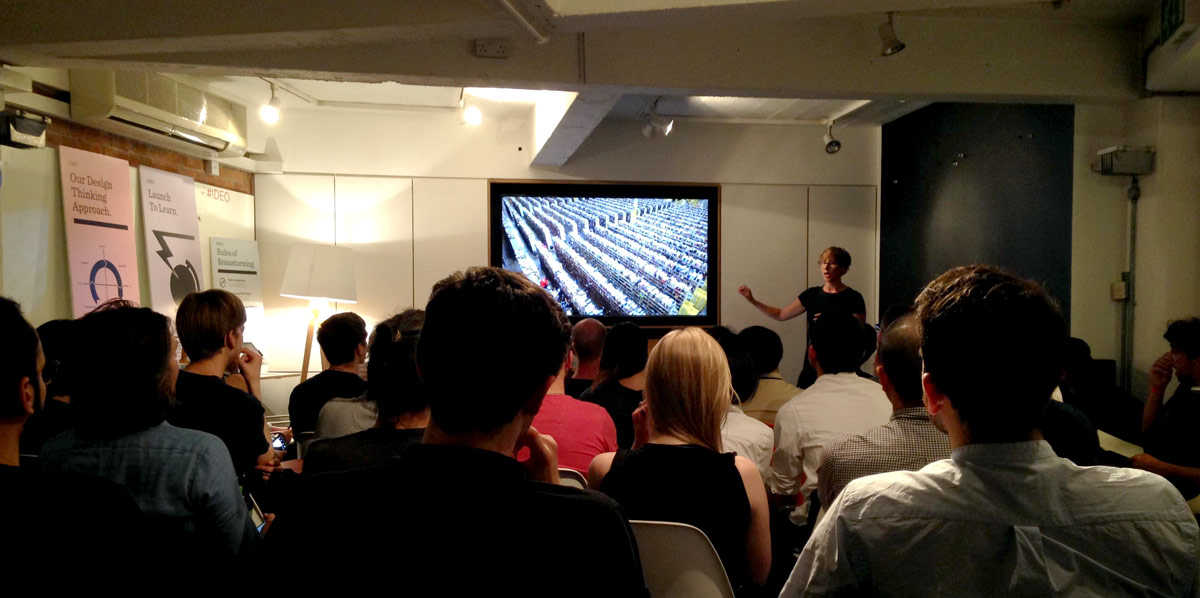
As the Internet of Things infiltrates the mundane moments of our daily lives, ubiquitously embedding intelligence into objects and environments – our relationships with technology become increasingly dynamic, contextual, and intangible. Therefore as interaction designers, how do we design what could and should be the resulting invisible dialogues between people, places, and things?
This month we will shift our attention away from classic, explicit interaction paradigms – those that demand our attention for direct engagement and manipulation – to implicit interactions that seamlessly behave in the background. Join us for product, prototyping, and research perspectives as we hear from Hongbin Zhuang, CEO and Co-founder of Olly robot; Karey Helms, a Senior Interaction Designer at Zebra Technologies; and Alex Taylor from Microsoft Research.